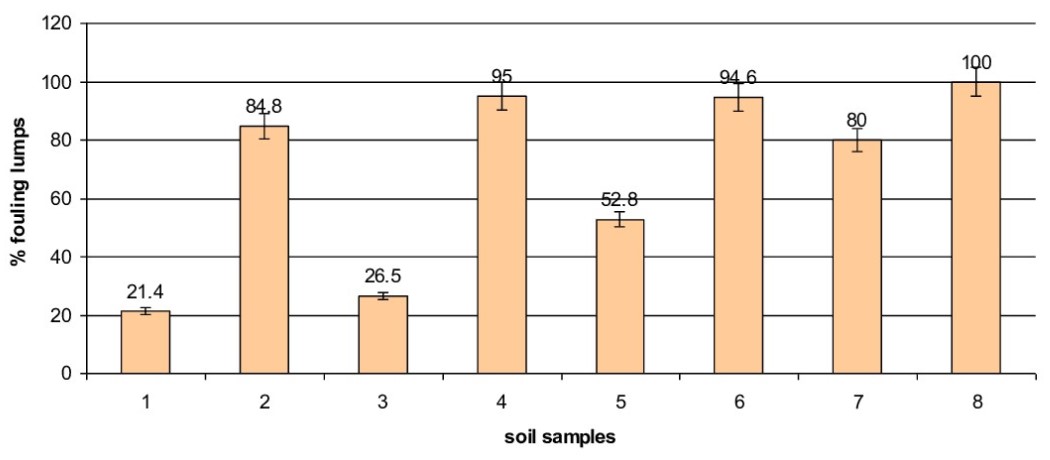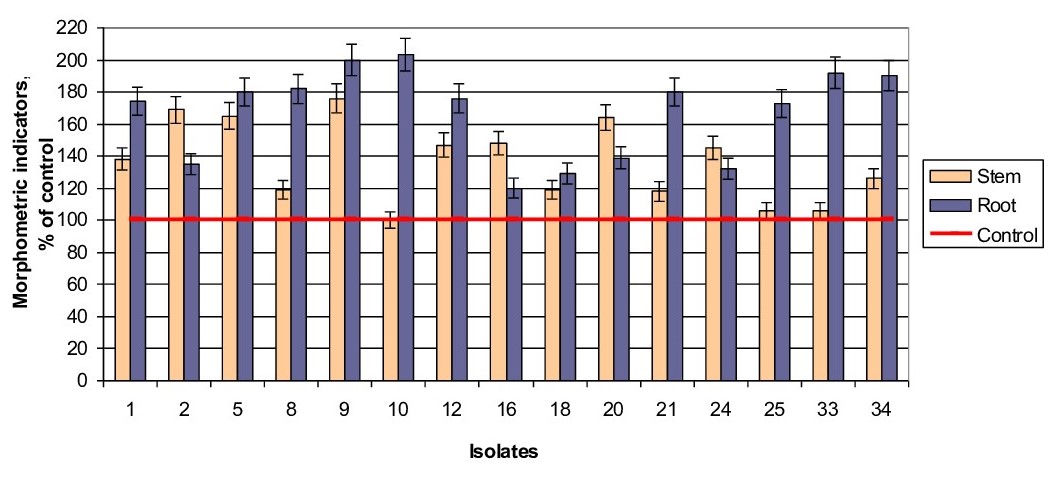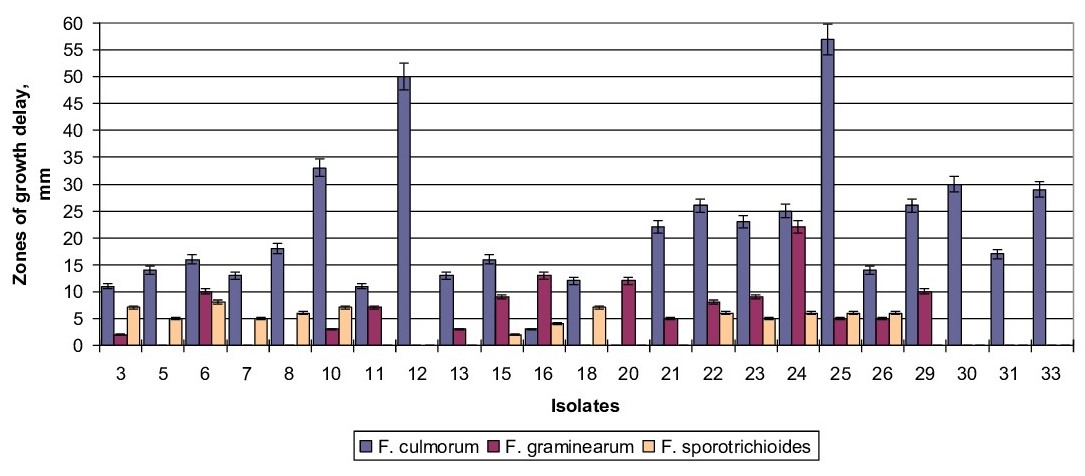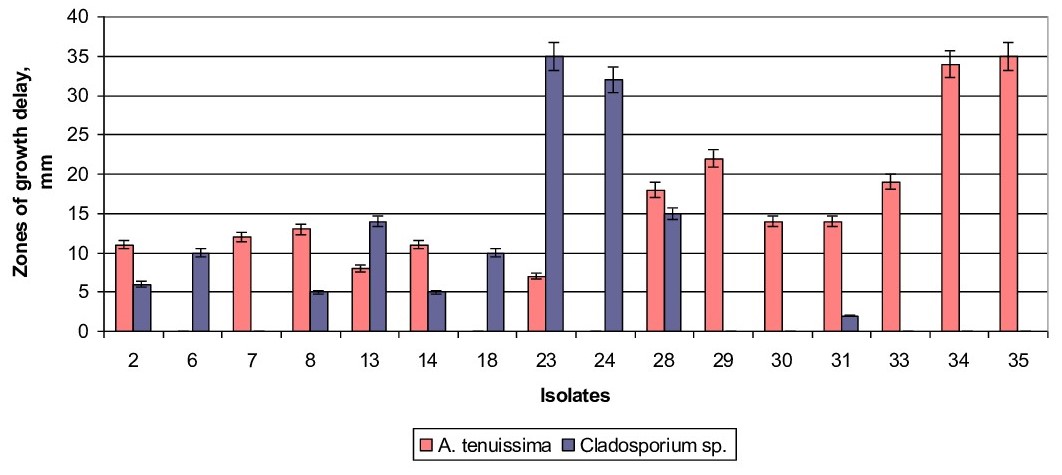PROMISING PROPERTIES OF SOIL NITROGEN-FIXING BACTERIA OF ASTRAKHAN REGION IN RUSSIA
PROMISING PROPERTIES OF SOIL NITROGEN-FIXING BACTERIA OF ASTRAKHAN REGION IN RUSSIA
Abstract
Nitrogen-fixing bacteria contribute a substantial amount of nitrogen in agroecosystems, especially in those which are subject to adverse natural and anthropogenic factors. This study aims to seek nitrogen-fixing microorganisms from the soils of the Astrakhan region in Russia. From 8 soil samples taken from recreational and industrial areas 35 isolates were isolated, their cultural-morphological and some physiological-biochemical properties were studied. 15 isolates stimulated the growth and development of roots and seedlings of seeds of a test-plant up to 200% in comparison with the control. Some isolates showed antagonistic activity against phytopathogens, such as micromycetes of the genus Fusarium, Alternaria and Cladosporium. As a result of the research, all isolates were divided according to the degree of manifestaion of useful properties and isolates with several of the studied activities were determined. The obtained native isolates can be used as microbial biological products for use in agriculture in arid climate.
1. Introduction
Soil is a dynamic natural resource and a substantial component of all at-ground ecosystems, as well as a major production source in agriculture and forestry. Urban soils still poor-studied biological systems strongly different from other natural systems taking into consideration their properties. Among their characteristic features are: mosaic structure and profile irregularity, considerable soil compaction, medium alkaline reaction, toxic pollution .
Fertility, fitness for urban planting and green areas, protection against pollutants are among the most important features of urban soils. Special role in preserving their fertility belongs to bacteria – participants of nitrogen circulation in nature. Nitrogen-fixing bacteria (NFb) play a key role in the process of nitrogen circulation, as they turn atmosphere-contained molecular nitrogen unavailable for plants into the bound one, thus enriching the soil with nitrogen compounds.
These are aerobic bacteria, gram-negative, pleomorphic, catalase-positive that can function in diverse organizational pattern – either single-living, or arranged in chains or clusters. Representatives of this genus are found in soils throughout the world .
There is still an extreme deficit of necessary information on the peculiarities of the development and activity of NFb extracted from urban soils in Russia. NFb can serve indicators of the soil ecological status, as they are very sensitive to various kinds of pollutants (oil hydrocarhydrocarbons, heavy metals, etc.) and to changes in their living conditions. Besides, certain cases of these microorganisms’ adapted strains obtained from the polluted environment are recorded , being an important proving for their further application. Azotobacter’s state and its stress-conditioned activity are manifested by such markers as its tinctorial power and tinting pattern, degree of sliming, forming of cysts and capsules.
For a long time, the positive impact of nitrogen-fixers upon soils has been explained by their ability to fix molecular nitrogen. Currently, it has been established that NFb are able to actively dissolve inorganic and organic phosphates , to provide plant nutrients access to plants
, , to produce physiologically active and growth-promoting substances , to show antagonistic activity against phytopathogens that cause plant diseases . Many authors prove the prospects of applying NFb as biologicals being an alternative to chemical fertilizers , , , as biologicals are cost-efficient, harmless for the environment, self-reproducing and specific for the regional peculiar conditions . Due to that, active search, identification, research and application of corresponding strains being a substrate for producing biologicals is becoming a major current trade in worldwide agrobiotechnology.The aim of the present research is to isolate and study the NFb of Astrakhan region soils with further selection of biotechnologically promising cultures.
2. Research methods and principles
2.1. Research objects
The objects of the research are presented by 35 isolates that were extracted from 8 soil samples taken in recreation zone (sample numbers 1-4) and industrial zone (sample numbers 5-8) of the city of Astrakhan and Astrakhan region.
2.2. Collection of samples and extraction of NFb
Sampling was made in the following spots within the territory of the city of Astrakhan and Astrakhan region.
1 – the city park named after V.I. Lenin (this oldest municipal park was established more than 100 years ago);
2 – municipal public garden named after G. Aliev (established in 2011. The newest city park with imported soils and embedded irrigation system for watering the plants that are not typical for Astrakhan region);
3 – forest area (forestland established in late 1800s on the territory of Astrakhan region, about 150 km from the city of Astrakhan);
4 – Baer knolls (single-storey residential zone on the territory of the unique natural object, 40 km from the city of Astrakhan);
5 – territory of the confectionery factory, the city of Astrakhan (food-manufacturing company);
6-7 – construction sites of the industrial zone, the city of Astrakhan;
8 – territory of the canning plant, the city of Astrakhan (territory of the fire damaged industrial enterprise).
The method of fouling lumps was used to isolate soil microorganisms, that are potentially capable of nitrogen-fixing, from the soils with application of Ashby’s agar nitrogen-free culture medium with sucrose . 20 soil crumbs were distributed upon the medium surface in Petri dishes, then cultured at the temperature 27°С during 7 days, till slime plaques emerging. Then they were taken to plate microorganisms for getting pure cultures.
Relative count of microorganisms in each sample under study was expressed in per cent as compared to the total number of the clods.
2.3. Study of culture-morphological and some biophysiochemical properties of isolates
Culture-morphological and certain biophysiochemical traits of the isolates were subjected to study. Visual investigation of the colonies’ cultural properties was conducted to define their size, surface, colour, slime formation. The morphological properties of the cells that had provided the building of the colonies were studied by microscopy with Gram’s staining.
Such properties of the isolates as mobility, catalase activity, range of the applied carbon-containing substances (rhamnose, arabinose, glucose, maltose and inositol) were investigated in accordance with Bergey’s Manual of Systematic Bacteriology .
2.4. Finding growth-promoting activity
To find out the growth-promoting effect of the isolates upon the seed germinating ability, development of roots and seedlings, the examined microorganisms were cultured in Ashby’s liquid medium at 27°С during 5 days. Seeds of garden radish (Raphanus sativus var. Radicula) were used as an experimental model test object.
The seeds were sterilized in 70% alcohol within 1 minute and then for 20 minutes in 5% sodium hypochloride solution. After that, the seeds were set out upon filter paper in Petri dishes and treated by the obtained microorganisms' suspension in equal amounts. Ashby’s sterile culture medium was used for the check-up experiment. The experiments were conducted with fourfold replication. Average values recorded in each experiment are given in the graphs.
Growth-promoting activity toward the seeds was evaluated by the difference in experimental and check-up values of germinative and morphometric indicators of the sprouted seeds. The results obtained in the check-up variants of the experiment were taken for 100%, and thus, values of the indicators in the experimental variants were calculated with reference to this number.
2.5. Finding activity towards phytopathogenes
Research of antagonistic properties of the microorganisms under study toward phytopathogenic fungi was made in Petri dishes in potato-glucose agar . Suspension of spores was plated upon agar medium, and the examined culture was introduced by an injection upon the fungus lawn. The dishes were incubated in thermostat at 28°С during 3 days. Emergence of inhibition zone of the test-fungus growth around isolates colonies made it possible to find out the antagonists.
Phytopathogenic fungi (Fusarium culmorum, F. graminearum, F. sporotrichioides, Cladosporium sp. and Alternaria tenuissima) , were used as test objects to define the range of the antagonistic effect of the examined isolates. They were contributed by Federal State Budget Scientific Institution All-Russia Research Institute for Agricultural Microbiology (Saint-Petersburg).
2.6. Statistical Analysis
An analysis of the rate of variation (standard deviation) at p ≤ 0.05 to determine the reliability of the results. The experiments were conducted with fourfold replication. The obtained experimental data were statistically processed by Statistica 6.1 and Microsoft Excel for Windows.
3. Main results
3.1. Selection and specification of pure cultures of NFb

Figure 1 - Amount of microorganisms potentially capable of nitrogen-fixing in the soils of recreation zone (points 1-4) and industrial zone of the city of Astrakhan and Astrakhan region (5-8)
Minimum amount of peds overgrown with pigmented thick mucous colonies of microorganisms was found in the samples taken in points 1 and 3 (21.4 и 26.5% respectively). Sufficiently high amount of microorganisms were found in sample 2 (84.8%), that had been taken on the territory of public garden named after G. Aliev, established in 2011 and being the newest city park, and in sample 4 (95%) – territory of Baer knolls low-rise residential development.
Samples that had been collected in the industrial zones showed high counts of microorganisms in samples 6 and 7 (80-94.6%), that is, in the estates intended for residential development. Meanwhile, the maximum count (100%) was found in sample 8, on the spot of the fire-effected industrial territory.
So, the obtained result can be explained by getting mineral and organic substances as combustion products into the soil.
To isolate pure cultures of microorganisms, subculture was made by passaging from the surface of the overgrown peds on the soil crumbs to Petri dishes with Ashby’s medium. Totally, 35 pure cultures were isolated. All of the isolated microorganisms demonstrated good gaining of biomass in Ashby’s nitrogen-free medium, formed pigmented and strongly slimed colonies.
The further step was to study cultural properties of the isolated colonies. The total amount of the selected isolates was divided in 3 groups in accordance with their cultural properties. The most numerous group (I) (68.6% of the total amount of the isolated pure cultures) was presented by 24 isolates forming slimy non-transparent colonies of irregular shape with convex profile, repand edge, smooth surface, homogeneous structure and dark-brown pigment. Another group (II) (20%) was presented by 7 isolates forming slimy laccate colonies of irregular shape with convex or hummocky profile, repand edge, coarse-grained or homogeneous structure, rugate surface and yellow pigment. The final group (III) (11.4%) performed 4 isolates that gave slimy laccate colonies of regular shape, with convex profile, repand edge and homogeneous structure, smooth surface, light-yellow or light-brown pigment.
Study of the morphological properties of the cells that had formed the colonies was carried out with application of specially prepared fixed products, then they were stained according to Gram’s method and subjected to microscopy. Morphology of the cells, their tinctorial properties, presence of cysts and/or capsules were observed in the products and recorded. Among the examined cultures, there are sustainably rod-shaped ones (37.2%), oval-shaped (37.1%), as well as pleomorphic forms (25.7%). Cysts and capsules are detected in 15 isolates, only capsules are found in 13, and 7 isolates form neither cysts nor capsules.
The received data show that all of the isolates studied by Gram’s method got negative staining, demonstrated mobility and catalase positive reaction. All these characteristics and also the experimental results with consideration of the degree of using diverse carbon sources give grounds to suppose that the selected isolates can belong to the Azotobacter genus , , . To define, differentiate and classify the selected isolates according to their genus and species assignment, additional studies are necessary.
3.2. Growth-promoting activity
Growth-promoting ability of the isolates was established in laboratory setting. The reaction of the test-plants (garden radish seeds) was estimated by the following parameters: seed germination, power and seedling vigor, length of the seedlings’ roots and stems.
When calculating the number of the emerged seedlings it was established that four examined isolates (7, 13, 23, 27) inhibited the germination of the test-plants seeds by 10-20 % as compared to the check-ups. The rest cultures demonstrated a stimulating effect by 10-12.5 % higher than in the check-up samples.

Figure 2 - Morphometric indicators of experimental test-plants seedlings
Impact of a number of isolates (sample numbers 5, 8-10, 21, 33, 34) resulted in credibly increased root length - from 1.8 to 2 times as compared to the check-up (р<0.05). The impact of the remaining isolates upon the root growing was weaker, but still, their application provided positive effect and was 1.3-1.7 times higher than values of the check-ups (Figure 2).
Stimulating impact upon the development of seedlings’ stems was made by isolates 2, 16, 20 and 24 (Figure 2), the seedling stem length increased by 1.5-1.7 times as opposed to the check-up. Maximum stimulating effect upon the root and stem of the test-plants seedlings was made by isolates 5, 9 and 20 (Figure 2).
3.3. Activity against phytopathogens
In the course of the research of isolates’ antagonistic properties against Fusarium culmorum, F. graminearum, F. sporotrichioides, Cladosporium sp. and Alternaria tenuissima it was discovered that influence of isolates resulted in inhibiting micromycetes growing (zones of growth delay emerged around the bacteria colonies) and mycelium pigmentation changing.

Figure 3 - Isolates antifungal activity against hyphal microfungi of Fusarium genus

Figure 4 - Isolates antifungal activity against hyphal microfungi of Alternaria tenuissima and Cladosporium sp.
Only six examined isolates performed their ability to inhibit Cladosporium sp. growth (Figure 4), and isolates 23 and 24 demonstrated maximum values (35 and 32 mm).
Considerable morphological changes in the test-fungi mycelium structure as compared to the check-up samples were also observed and recorded – the process of sporogenesis in antagonists’ operating zone was slowing, mycelia threads experienced injuries, forming of septate bead-string-like mycelium showed frequent occurrence.
4. Discussion
Currently, development of PGPR-strain-based biologicals and bio-fertilizers, including NFb, and their introduction into farming practice, is getting special importance. There is a worldwide demand for such studies that are closely related to meeting specific regional and farming requirements.
The efforts to define the count of microorganisms in the investigated soil samples have brought rather ambiguous data. Totally, the count of microorganisms varied from 21.4 to 100%. Lower count of the selected microorganisms in points 1 and 3 can be explained by their exactingness to the habitat conditions and the current state of these spots.
High degree of detecting microorganisms in the soils in the industrial area can indicate emerging of a sustainable community of the observed microorganisms that has formed as a result of longstanding impact of harmful conditions and the defense reaction of cells to such effects (formation of colonies with anomalous leaky growth, strong sliming, dark-brown pigmentation, formation of capsules and cysts).
The obtained isolates are adapted to climate conditions of Astrakhan region and can be used for further investigations as a substrate for biologicals.
The complex of markers makes it possible to classify the obtained isolates as belonging to the Azotobacter genus. To define the selected isolates’ genus and species assignment more detailed research is to be conducted to present their further differentiation.
It was found out that representatives of morphological group 1 (that form slimy colonies with irregular shape and dark-brown pigment), occur in the examined soils more often than others. This fact correlates with the research of Wakarera et al. , where it was shown that some kinds of NFb possess higher affinity to certain types of soils and, therefore will be developing and more effectively producing metabolites that would facilitate plants growing just in the described conditions.
When estimating growth-promoting activity, we selected 15 isolates that had shown favorable impact upon growth and development of seedlings of the test-plants. Discovered ambiguous effect of some isolates and products of their metabolism upon the test-plants seeds can be the evidence of producing diverse classes of biologically-active compounds, such as hormone-like substances, vitamins, enzymes and some others. Thus, dominating development of roots in the test-plants seeds influenced by some isolates in comparison with their stems was well seen. Some authors , suppose that this phenomenon demonstrates production of auxins, particularly, indolyl-3-acetic acid.
Some isolates demonstrated not only positive effect upon growth stimulation and development of test-plants seeds, but also showed their antagonistic activity toward pathogenic micromycetes of Fusarium, Alternaria and Cladosporium genus. This correlates with the findings of Jnawali et al. that demonstrate antagonistic properties of Azotobacter genus isolates toward micromycetes of the following genera: Alternaria, Fusarium, Rhizoctonia, Macrophomina, Curvularia, Helminthosporium and Aspergillus .
Significance of microorganisms capable of nitrogen-fixing to perform their antagonistic properties is stressed by some authors , , , but there is practically no information of this type of strain in Astrakhan region.
Wakarera et al. also point that plant protection mechanisms can be linked to manifestation of the whole complex of such useful properties in microorganisms as production of siderophores, antiinfection agents, toxins, growth-promoting hormones (auxins, gibberellins, cytokinins).
The conducted experiments resulted in classifying isolates according to the degree of their useful properties' manifestation, and also in separating some isolates with a number of the studied activities. These types of isolates provide promising grounds for further investigations and developments of biologicals with comprehensive effect and favorable influence upon soils and plants in Astrakhan region environment.
5. Conclusion
The conducted research made it possible to find out and select aboriginal isolates potentially capable of nitrogen-fixing in Astrakhan region soils. Detecting isolates that exercise one or several activities described in the present paper, demonstrate significant prospects and definite importance of the research.
The selected isolates, in case they will be investigated further, can find application as microbial products in agriculture in arid climate.
